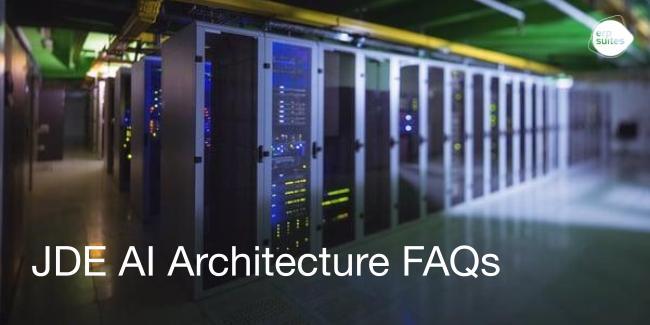Top 5 Problems JD Edwards Users Solve with AI
December 18th, 2023
5 min read

JD Edwards remains one of the most capable ERP systems, but in many organizations, its full potential is still out of reach. Manual data entry, slow reporting, unpredictable supply chains, and complex user experiences can hold teams back from working efficiently. As business moves faster, traditional processes built around static data and human intervention simply can’t keep pace.
Across industries, JD Edwards users are discovering that artificial intelligence is the key to bridging that gap. AI-powered solutions are already automating order entry, predicting demand, streamlining financial closes, and even enabling natural-language interactions within JDE. Oracle’s continued investment in Orchestrator, hybrid cloud capabilities, and AI-ready APIs has made it easier than ever to embed intelligence directly into JDE workflows. The results: faster decisions, greater accuracy, and measurable cost savings.
In this article, we explore five of the most pressing challenges JD Edwards users face and how AI is helping to solve them. From eliminating manual tasks to turning data into real-time insight, these solutions show how intelligent automation can transform JDE from a transactional system into a proactive driver of business performance.
How AI Eliminates Manual Sales Order Entry in JD Edwards
For many JD Edwards users, sales order entry remains a high-volume, manual process that consumes time and invites errors. Customer orders often arrive in multiple formats, spreadsheets, PDFs, emails, requiring staff to key data, verify details, and chase approvals. This slows fulfillment ties up resources and creates a costly bottleneck just when speed and accuracy are critical to customer satisfaction.
The Impact of AI
Modern AI technologies are changing this dynamic. With intelligent document processing, natural-language understanding, and predictive validation models, incoming orders can be automatically read, verified, and routed directly into JDE Orchestrator workflows. Machine learning models flag exceptions, while integrated AI services can recommend substitutes or upsells when inventory runs low. The result is an end-to-end process that runs with minimal human intervention but full transparency.
The Outcome
Organizations adopting AI-driven order automation report dramatic efficiency gains, faster cycle times, fewer data-entry errors, and improved cash flow. Instead of spending hours re-entering information, teams focus on customer relationships, proactive selling, and service quality. AI transforms order management from a manual back-office task into a strategic advantage that scales with business growth.
AI Turns JD Edwards Data Overload into Real-Time Insights
JD Edwards users often spend more time creating reports than interpreting them. Each department builds its own dashboards and spreadsheets, resulting in fragmented views of the business. By the time data is reconciled and shared, it’s already outdated, leaving decision-makers reacting to yesterday’s information. Static reporting not only slows response time but also hides emerging trends, risks, and opportunities buried in transactional data.
The Impact of AI
Modern AI-powered analytics platforms change the equation. By using machine learning and generative AI, organizations can uncover hidden patterns, forecast performance, and receive real-time insights in plain language.
Predictive models can stream data directly into dashboards, automatically flag anomalies, or even summarize key metrics in conversational form, allowing teams to ask questions like:
-
“What’s driving this quarter’s margin drop?”
-
“Which suppliers are trending late on deliveries?”
The Outcome
JD Edwards users who adopt AI-driven analytics gain the speed and clarity needed to act decisively. Instead of chasing numbers, leaders can anticipate outcomes, correct issues earlier, and make data-backed decisions that boost profitability and resilience. By embedding AI into reporting workflows, organizations replace information overload with insight and turn data into a daily competitive advantage.
Using AI in JD Edwards to Predict and Stabilize Supply Chains
In today’s unpredictable environment, supply chain stability is a moving target. JD Edwards users often struggle to align purchasing, production, and inventory with real-time demand. Traditional planning relies heavily on historical data and static forecasts, which can’t keep up with sudden shifts in customer behavior, supplier reliability, or market conditions. The result: excess inventory one month and costly shortages the next.
The Impact of AI
AI brings adaptability and foresight to supply chain management. Using machine learning models trained on both internal JDE data and external variables, such as supplier performance, transportation costs, or weather trends, organizations can forecast demand with far greater precision.
AI-powered systems identify early warning signals and recommend dynamic adjustments to production schedules, reorder points, and safety stock. These recommendations can automatically trigger purchase orders, supplier communications, or scheduling changes, keeping operations aligned in real time.
The Outcome
Companies leveraging AI-enabled forecasting gain a sharper, more agile supply chain. They reduce stock outs and carrying costs, shorten planning cycles, and improve service levels even in volatile conditions. Instead of reacting to disruption, JD Edwards users can now anticipate it, turning uncertainty into a strategic advantage powered by intelligent automation.
Speeding Up JD Edwards Financial Closes with AI Automation
Month-end close in JD Edwards can feel like a race against the clock. Finance teams chase reconciliations across spreadsheets, verify journal entries by hand, and manage approvals in disconnected systems. The process is repetitive, time-intensive, and vulnerable to mistakes that delay reporting or erode confidence in the numbers. With growing transaction volumes and compliance demands, traditional close cycles can no longer keep up.
The Impact of AI
AI is reshaping finance by turning closing and reconciliation into continuous, intelligent processes. Machine-learning models now classify transactions automatically, detect anomalies in real time, and match invoices, payments, and journal entries without human intervention. Predictive analytics forecast cash-flow fluctuations and identify potential compliance issues before they occur.
These insights can trigger actions like automated approvals, exception routing, or inter-company settlements, keeping data accurate and workflows moving. Conversational AI tools even let users ask questions like:
- “What’s driving our AP variance this quarter?”
- “Which accounts are delaying close completion?”
The Outcome
JD Edwards users applying AI in their financial processes are shortening close cycles, reducing manual workload, and improving audit readiness. Continuous accounting replaces the month-end scramble with real-time confidence in results. With transparent automation and predictive insights, finance teams spend less time reconciling and more time analyzing performance, turning financial operations into a strategic function that fuels business growth.
How AI Assistants Simplify JD Edwards Navigation and Usability
JD Edwards is a robust system built to handle the complexity of enterprise operations. But for many users, that power comes at a cost: navigating multiple menus, reports, and transactions just to find a single answer. Even experienced users spend valuable time searching for data or waiting on IT for custom queries. This complexity creates friction, slows adoption, and keeps valuable insights locked behind technical barriers.
The Impact of AI
Conversational AI and digital assistants are transforming how users interact with JD Edwards. Integrated with JDE Orchestrator and powered by large language models (LLMs), these JDE digital assistants let employees ask questions in plain language and get accurate, data-driven answers instantly.
Examples include:
- “Show me our open sales orders over $50,000.”
- “What’s the current forecast for raw materials?”
- “Create a purchase order for our top vendor at last month’s price.”
Behind the scenes, the JDE Orchestrator connects your data to a digital assistant, such as the Oracle Digital Assistant, so you can communicate in natural language to perform real actions, run reports, initiate workflows, and surface insights.
The Outcome
AI assistants eliminate barriers between users and information. Employees no longer need deep system knowledge to access real-time data or complete transactions. By simplifying interaction and increasing accessibility, AI extends the value of JD Edwards across the organization, empowering every role, from the shop floor to the boardroom, to make faster, smarter decisions.
Moving Forward: From Problem to Possibility
JD Edwards users are proving that AI isn’t just a future investment, it’s a present advantage. What once required hours of manual work, disconnected tools, and delayed insight can now happen automatically, intelligently, and in real time.
Each of the five challenges explored in this article represents an opportunity for transformation. With AI, these aren’t just pain points to manage; they become catalysts for agility, growth, and stronger decision-making.
As Oracle continues to enhance, JD Edwards organizations have every tool they need to build a smarter, more connected enterprise. The path forward can start small: identify one challenge, apply AI thoughtfully, and measure the impact.
At ERP Suites, we help organizations unlock the full potential of JD Edwards by embedding AI and automation into real business processes. Whether you’re looking to streamline operations, modernize your data strategy, or identify your first high-impact AI use case, our team can help you get there.
When implemented responsibly and strategically, AI turns JD Edwards into more than an ERP. It becomes the intelligent backbone of a business that learns, adapts, and leads.



.png?width=650&height=325&name=Blog%20Images%202_1%20(4).png)
.png?width=650&height=325&name=Blog%20Images%202_1%20(5).png)
.png?width=650&height=325&name=Blog%20Images%202_1%20(3).png)
.png?width=650&height=325&name=Blog%20Images%202_1%20(2).png)
.png?width=650&height=325&name=Blog%20Images%202_1%20(1).png)
.png?width=960&height=540&name=Blog%20Images%20(96).png)

.png?width=960&height=540&name=Blog%20Images%20(90).png)
.png?width=960&height=540&name=Blog%20Images%20(88).png)
.png?width=960&height=540&name=Blog%20Images%20(87).png)
.png?width=960&height=540&name=Blog%20Images%20(86).png)
.png?width=960&height=540&name=Blog%20Images%20(85).png)
.png?width=960&height=540&name=Blog%20Images%20(83).png)
.png?width=960&height=540&name=Blog%20Images%20(82).png)
.png?width=960&height=540&name=Blog%20Images%20(80).png)